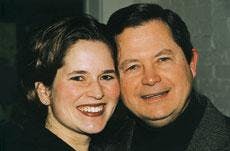Riding the 'Extreme Makeover' WavePart 1 of 2: Points for Success
By Amy Morgan, CEO, Pride Institute
Many dentists and patients have seen the ABC program "Extreme Makeover," which awards a few lucky people appearance overhauls that include cosmetic surgery and aesthetic dentistry. The show comes at an auspicious time for dentists since the economy is improving. People have more discretionary cash and baby boomers are wanting to slow the aging process, improve their looks, and maintain their health. The overriding message of "Extreme Makeover" is that Americans want to look better.
"Extreme Makeover" presents opportunities to dentists. We see on prime time television a new image of dentistry, one no longer associated with pain or the butt of jokes. "Extreme Makeover" links dentistry to miracle procedures that significantly improve appearance and self-confidence. The show gives the dental profession tons of free marketing. Whether you want to specialize in cosmetics or in preserving long-term oral health, you may benefit by riding the "Extreme Makeover" wave. Judging from the show's popularity, Americans are ready to embrace a new image of dentists as heroes. Are you ready to answer the call?
To help you build your cosmetic practice, we'll give you Pride's musts for success and illustrate how actual doctors studying with us have applied these principles to ride the makeover wave. Next month, we'll review obstacles to overcome and expand on Pride's "how-tos," our blueprint for implementation. We chose to highlight successful solo-dentist practices, some with production numbers that double the national average. We included practices in smaller cities and towns to show that you don't have to be in Beverly Hills, Calif., or New York City to do makeover dentistry. Our doctors' stories illustrate that practice management skills are essential to achieving clinical and professional success.
"Extreme management has to go along with extreme makeovers," says Dr. Mark Adams, a Pride prosthodontist in Flint, Mich. (More about Adams will follow in Part 2.)
Armed with this new information, let's ride the wave together.
Strategies of successful dentists
Pride Point 1)— Create, upgrade, and reinforce your treatment philosophy for success.
Meet two Pride doctors. Dr. Ban Barbat is a young general dentist in the suburban Detroit town of Shelby Township, Mich. She calls her Web site ExtremeMakeoverDetroitStyle.com. Barbat crafted a long-term plan when she opened her practice 10 years ago. Her vision is to provide comprehensive care.
First, she immersed herself and her team in management training to create a high-quality office and professional staff to support her clinical dreams. Then, she took extensive, hands-on advanced clinical courses, again including her staff in the training so they would understand new procedures and share her enthusiasm.
Dr. Walter Brown, a general dentist from Kokomo, Ind., also has responded to the "Extreme Makeover" interest by building his practice philosophy of providing complete cosmetic care. His growing level of production is a testament to his philosophy and rivals that of the most successful dentists in the largest cities.
Having already implemented a plan for providing comprehensive and aesthetic care, Barbat and Brown were well-poised to perform and manage cosmetic dentistry when "Extreme Makeover" appeared on television, Barbat says.
"When people get a smile makeover and notice the difference it makes to their faces and self-confidence, it's a really good thing for them and also for me as their dentist," she says. "To do a makeover, I personally feel good knowing I made a difference in someone's smile and in his or her general oral health. And it's productive from a business standpoint, so it's a win-win."
Pride Point 2)— Create and expand a marketing profile that will align with your practice's philosophy and goals.
Barbat's husband and business partner, Joe Dindo, says they used the television program as another marketing tool.
"We're advertising on TV, radio, and print," he says. "Last fall, we ran local TV ads during ABC's 'Extreme Makeover' program. At the same time, we ran daytime TV spots that focused either on our conscious sedation for high-fear patients or on our cosmetic dentistry. We mention our Web site in all of our marketing. Our Web site gets people enthused, with many before-and-after pictures and testimonials from happy patients. The result of the TV ads was that we received a lot of calls and a doubling of our Web traffic.
"We measure our new patient value from different sources, and we know that our Web inquiries result in a higher dollar amount of treatment accepted, partly because our Web site gets hits from patients interested in cosmetics and partly because patients from the Web, we find, have been shopping around and are aware of what cosmetic procedures cost.
"There's also strong word-of-mouth out there. We get as many new patients from internal referrals from patients of record as we do from outside advertising. And we see a higher retention of internally referred patients. We're spending money on media advertising, but hardly spending anything on internal referrals — and we're getting the same number of new patients from each. However, we also track our comprehensive care patients (those requiring a quadrant or more of restorative or aesthetic dentistry), and we find that more of them are coming from outside advertising, which is mainly focused on cosmetics, than from internal referrals. We're moving into a new facility and planning to run an extreme makeover contest with media coverage to introduce it."
Brown's daughter, Mary Elizabeth Cameron, develops marketing programs for her father's practice.
"We focus our ads either strictly on aesthetics or on the fact that Dr. Brown is also a general dentist. We run two billboard ads year-round that are rotated every five weeks so we cover the entire town in one year. We also run a local TV commercial 26 times per week. It's pretty affordable when you catch specials. A patient whom Dr. Brown did full-mouth veneers for appears in one commercial with him. I also run a monthly cosmetic ad in our newspaper's bridal section and a general practice ad in the business section, plus newspaper ads quarterly in neighboring towns.
"Working with a radio station that targets upper-middle-income people from 50 miles away in Indianapolis, and partnering with a plastic surgeon and a spa owner, Dr. Brown is giving away an extreme makeover as part of a contest. Applicants are writing an essay, and each partner in the makeover will select the finalists, with the radio station picking the winner. To our knowledge, no one's ever tried a radio makeover before. There's been a great response so far, and we're getting 400 minutes of radio advertising, which is very affordable with our makeover partners sharing the cost."
Pride Point 3)— Create an easy-to-track, statistical interpretation of all aspects of your makeover success.
Comprehensive marketing can be costly and ineffective if doctors do not monitor the results to measure success. Barbat's team monitors all marketing efforts, Dindo says.
"First, let me say that we track everything. It's part of everyone's job at the front to track each and every media placement," Dindo says. "We determine for every caller how he or she heard about us. Then the call is logged into our tracking system so we can generate monthly reports. When new patients come in, they're mentioned at the morning huddle, where we review their major objectives, their primary concerns, and how they were referred to us, so the clinical staff has that information. Then in the operatory, their referral sources are confirmed. That's when we get the whole story. It usually goes like this, 'I saw your TV commercial, and I remembered hearing you on the radio, then I picked up the paper last week and saw your ad.' It's rarely ever just one source, but our broad-based marketing that has been effective. Or they'll say, 'I saw your ad on TV, and I went to your Web site. Wow, what a beautiful Web site!' We look for a quick answer on the phone and the whole story of how new patients found us when they arrive.
"So far in 2004, we've seen a doubling in the number of comprehensive care cases that we have gotten. I'd say that the 'Extreme Makeover' show has impacted our practice. There seems to be an increased population awareness due to both the show and our advertising."
Cameron uses a similar strategy. She says people working in her father's office ask callers how they've heard about Dr. Brown.
"Most say they were referred by another patient," Cameron says. "When they come in, we ask if they've seen the billboards or print ads or heard the radio spots. They usually have, which prompts them to ask around about us, so our ads are working in conjunction with internal referrals to bring in patients."
Pride Point 4)— Train yourself and your team to the highest level of clinical excellence, systems management, and customer service.
Other general dentists who want to do more cosmetic dentistry often look to Barbat for advice.
"Take the classes you need to do the treatment," Barbat says. "If you don't have the skills, nothing else will matter. And make the treatment affordable for the patient. Of course, you need practice management training. I've been doing that for so long that I take it for granted, but you definitely have to know how to handle the financial arrangements, marketing, tracking, scheduling, and case presentation for managing the cosmetic cases."
Brown, who completes 100 to 200 hours of clinical continuing education each year plus management training, echoes Barbat's sentiments.
"We take courses on cosmetic dentistry, occlusion, implants, and prosthetics," Brown says. "The staff gets trained, too, because they're an important part of our success, and they're more enthusiastic and informed when they attend courses. The staff does a marvelous job of creating ways for people to afford treatment."
Pride Point 5)— Make sure your financial systems support the practice's goals for profitability and the patients' goals for ideal dental care.
Cameron says production at Brown's practice varies each month.
"Our average high-end case runs from $5,000 to $8,000. Although we've had some that ran over $30,000, we don't get those every month," Cameron says. "We get two high-end cases a month, which add $10,000 or more to our monthly production. We find that cost isn't an issue when we do these cases. I can't think of anyone who didn't accept treatment because of that. Time is usually the issue.
"We offer the patient three main payment options. Dental Fee Plan gives us a monthly payment sheet. When patients see they only have to pay $95 a month instead of $10,000, they go for that. It's our most popular option, with 50 to 60 percent of patients choosing it.
"Our second option is six months with no interest, which we finance internally. Jill Fischer, our front office coordinator, prepares a schedule for patients, sends them six coupons, and they send us their payments.
"The third option is 12 months at 8 percent interest. We do this through the office, too, and it's often cheaper than paying credit card interest. We don't extend payments past one year, and we don't have any trouble collecting. Collections actually ran at 100 percent for 2003. We don't hide behind our fees, which are some of the highest in Kokomo; we're very proud of them. We have written financial arrangements for anything over one crown. With a signature on file, no one argues.
"We have a very organized system for discussing finances, so patients feel confident that we know what we're doing. Dr. Brown and the clinical staff don't discuss fees; our front office staff does. Two weeks prior to the consultation, Dr. Brown works out a treatment plan from the patient's study models, intraoral pictures, and other data. Then, one week before the consultation, he, his assistant, and the financial coordinator meet to discuss the case. This gives the financial coordinator time to work out the payment options and assemble a packet for the patient. We can usually do the treatment in phases if time or cost is an issue, so we break it down into phases in case some patients choose this route. Then, if they only want to do a portion of the work now, we're ready. We have it broken down, so we don't have to rip apart the treatment plan and start over. As the financial coordinator is listening to what the patients are saying, she's able to separate out what they don't want to do from what they want to do immediately.
"We track case acceptance very closely for anyone having anything over one crown done, and we calculate the treatment accepted, scheduled, and completed, so nothing slips through the cracks. The figures are in our face all day. Our case acceptance rate for 2003 was 80 percent. We also increased our production by 20 percent. We strove for 13 new patients per month, but actually averaged 22."
Pride Point 6)— Create a team that supports and promotes ideal service and care.
Other aspects of Brown's successful systems include outstanding customer service, extensive use of expanded duties, and a motivated, well-treated staff, Cameron says.
"Dr. Brown has empowered our staff to serve as his advisory board with everyone in charge of something special," Cameron says. "I'm in charge of marketing. Another staff member in charge of patient relations set up a program in which each staff member has $100 per year to spend on patients, and she tracks how that's used. One person is in charge of supplies, ordering, and lab tracking. One is in charge of protocol like OSHA. Dr. Brown is in charge of CE. All the directors report at each staff meeting. Everyone plays an important role and gives 110 percent."
When I recently made a training visit to Barbat's practice, her team staged a mock new-patient exam. I was awestruck by the care each staff member took in making the exam special. The team was empowered and motivated to lead the way in care and service.
Barbat and Brown are two of many doctors who have increased their cosmetic cases through honing their treatment philosophies, marketing profiles, tracking systems, staff- and doctor-training strategies, systems management, and team development. In Part 2, we'll present an action plan to overcome obstacles. We'll implement the Pride points so that you, too, can ride the "Extreme Makeover" wave.
1) Create a treatment philosophy
2) Create a marketing profile
3) Create success statistics
4) Train to the highest level
5) Make finances support goals
6) Create a supportive team


